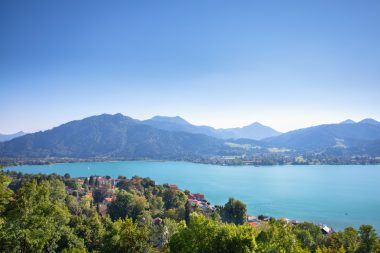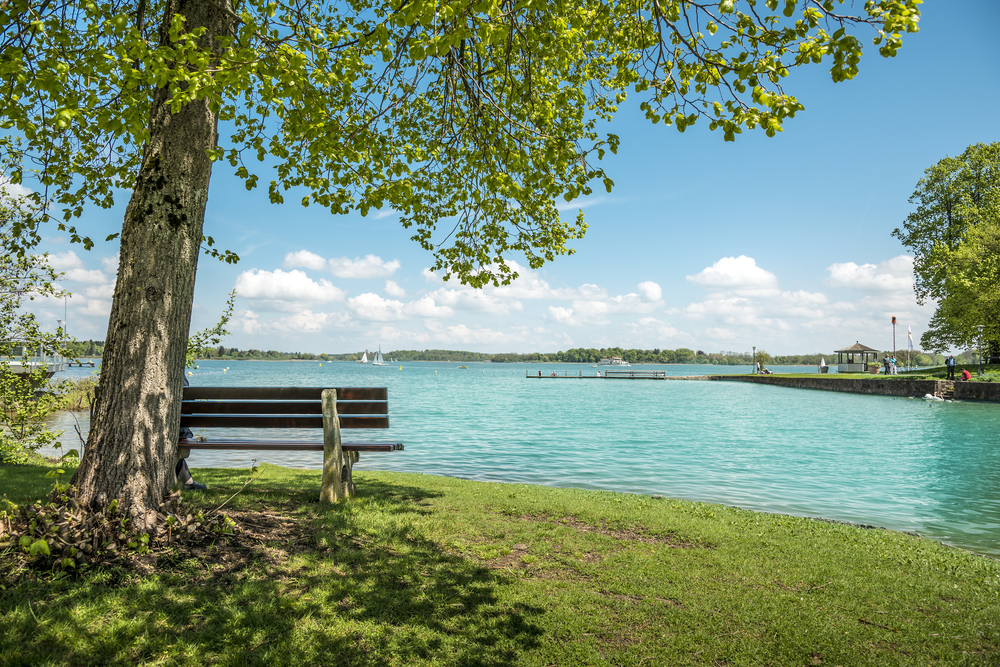The region of Upper Bavaria, which largely coincides with the 17,500 sq km administrative district of the same name, is one of the most important tourist destinations in Germany. In addition to the state metropolis of Munich and other Upper Bavarian cities such as Freising and Ingolstadt, the natural beauty of the region has contributed to this attractiveness. The numerous Upper Bavarian lakes in the region, embedded in alpine and pre-Alpine landscapes, are of outstanding importance.
More than 250 lakes are spread over Upper Bavaria. In addition to very large lakes such as the Chiemsee (80 sq km), the Starnberger See (56 sq km) and the Ammersee (47 sq km), there are a large number of small and very small lakes such as the five-hectare Weitsee near Traunstein, the warmest lake in Upper Bavaria in Waging or the Ampersee (8 ha) near Olching.
Chiemsee – The Bavarian Sea
Lake Chiemsee, twelve kilometres long and eight kilometres wide, is the largest lake in Bavaria. It is the centre of the Chiemgau holiday region, which belongs to the districts of Rosenheim and Traunstein. The lake is surrounded by the impressive rock massifs of the Chiemgau Alps with peaks such as the Hochfelln (1674 m). Spa and bathing resorts on the more than 60 km long shoreline include the “fair trade town” of Prien am Chiemsee, the marina town of Seebruck, which has a Roman museum, and Bernau am Chiemsee with its peat station. Lake Chiemsee has an excellent reputation as a destination for water sports such as sailing, diving or surfing.
Two lake islands, which are visited by the steamers sailing across the lake, are also prominent in terms of tourism. With 285 hectares, by far the largest of these two islands is the car-free Herreninsel with Herrenchiemsee Castle, built in the 1870s and 1880s, the “fairytale castle” of King Ludwig II, as the main attraction. The neighboring, also car-free Fraueninsel (15 ha) has 300 inhabitants and is an important place of pilgrimage with its Frauenchiemsee monastery.
Fünfseenland – Cultural and natural landscape near Munich
The Fünfseenland, which is very popular with Munich and Augsburg residents as a local recreation area, extends about 30 km southwest of the state capital within the area of the Munich S-Bahn network. In addition to the five main bodies of water that give it its name, this lake landscape includes Lake Starnberg, Ammersee, Wörthsee, Pilsensee and Weßlinger See. The scenic charm of the hilly to partly mountainous Five Lakes District with forest and meadow zones is complemented by cultural sights and a number of tourist offers. The best-known communities on the shores of Lake Starnberg (former name: Würmsee) are the district town of Starnberg with its lakeside promenade, the tourist community of Tutzing and Feldafing. Just before Feldafing, the two-hectare only lake island, the Rose Island, can be visited. Here you can walk in the footsteps of Empress Sisi, who had lived nearby in Possenhofen and regularly visited the island as a summer retreat. Another monarch, Ludwig II, is commemorated in the seaside town of Berg by Berg Castle and a memorial plaque on the shore where the Bavarian king died in 1886. Five kilometres west of the Lake Starnberg , the 16-kilometre-long and up to 80-metre-deep Ammersee invites you to swim, surf, fish and sail, cycle, run and have fun in the beer garden.
For ship fans, a trip with the paddle wheel veteran DIESSEN, which was launched in 1906, is a must. For fans of sacred buildings, on the other hand, a visit to the Marienmünster in the lakeside town of Dießen is a must on Lake Ammersee. On the four-square-kilometre Wörthsee, which is privately owned by the nobility, only a small strip of shore is open to the public. The Weßlinger See (17 hectares), on the other hand, is owned by the municipality and is considered the warmest bathing lake in the Five Lakes Region. The two-square-kilometre Pilsensee, which is partly protected as a nature reserve in the shore area and partly open to bathing, belongs to the castle municipality of Seefeld.
Tegernsee – pure Bavaria

The tourism experts of the region near the town of Tegernsee, located 50 km south of Munich, advertise with the claim that Bavaria is nowhere more Bavarian than in the Tegernsee area. In fact, the climatic health resort of Tegernsee, which is located on the lake of the same name, with its monastery castle and the town hall, which has its own jetty, its down-to-earth gastronomy and its rich customs have a lot of local colour. Lake Tegernsee, where the spa towns of Bad Wiessee and Kreuth are also located, is known for its excellent water cleanliness. The lake is not only popular with tourists and health seekers, but also a hotspot for congresses and seminars.
Königssee and Walchensee – deep alpine lakes
Like Lake Tegernsee, the emerald green Königssee (5 sq km) in the Berchtesgadener Land National Park, flanked by mountain slopes, also has excellent water quality. It is therefore ideal for a holiday in the Berchtesgadener Land. With a depth of 190 metres in places, Königssee is one of the three deepest lakes in Germany, as is Walchensee, which is two metres deeper (16 square kilometres, Bad Tölz-Wolfratshausen district). The two-towered pilgrimage chapel of St. Bartholomä, built on the Hirschau peninsula in the Königssee, which belongs to the municipality of Schönau, in the shadow of the Watzmann massif, is the architectural landmark of the Königssee. Hirschau, which also includes a hunting lodge that is now used as a restaurant, can only be reached via mountainous paths or by electrically powered sea steamer.
When visiting Königssee, we definitely recommend a detour to the Obersee section to experience the 400 m high Röthbach waterfall. As in Königssee, there are also some wrecks of motor vehicles and airplanes in Walchensee, which are not rusted in the oxygen-poor deep zones and are easily recognizable in the clear water. Due to its windless location in the Bavarian foothills of the Alps, Lake Walchensee is a highly valued area for sailors and surfers.


